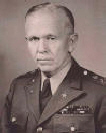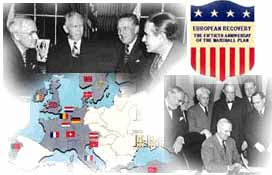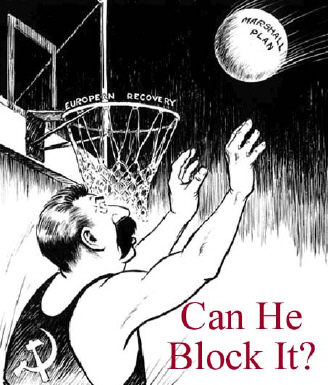Multiple Choice
Identify the
choice that best completes the statement or answers the question.
|
|
|
The Marshall Plan 1947 -
1952
With hunger and discontent
plaguing postwar Europe, the U.S. proposes an aid program to rebuild the ruined continent.
But
the Marshall Plan also solidifies the deep ideological differences between East and West
POSTWAR
EUROPE
| The events that brought about the Marshall Plan were spurred on by a
combination of man-made and natural disasters. Immediately following World War II, much of Europe was
in chaos.
Millions of refugees roam the continent, some attempting to return home after the war,
others fleeing westward, away from Soviet domination. Governments lie toppled, national
economies remain in ruin. | | |
Meanwhile, the harvest of 1946 is poor, and the winter of '46-47 is one
of the worst in memory. The strife leads many in Western Europe to consider communism as an end to
the hard life and injustices they suffer.
|
|
|
1.
|
What was the purpose of the
Marshall Plan?
a. | Help Europe get back on its feet and
prevent mass starvation | c. | Help prevent
starvation in the Soviet Union | b. | Equip an army to confront the Russians | d. | Help to rebuild Eastern Europe and prevent
starvation |
|
|
|
2.
|
How did World War II leave
Europe?
a. | revitalized | c. | wealthy | b. | inspired | d. | devastated |
|
|
|
3.
|
The passage suggests that there
was a danger that an economically devistatedd Europe with a starving population
might
a. | turn to
Capitalism | c. | turn to Hitler
again | b. | turn to Communism | d. | become challenge U.S. economic
power |
|
|
|
4.
|
Who were the refugees trying to
escape from in Europe?
a. | The
Nazi’s | c. | The
Russians | b. | The Americans | d. | Great Britain |
|
|
|
5.
|
Who suffered most in Europe
after World War II?
a. | The Soviet
Military | c. | The civilian
population | b. | The British and Americans | d. | The Communist Party members |
|
|
|

President Harry
Truman | TRUMAN
DOCTRINE
After
decades as a global power, Britain finds itself unable to cope with the growing postwar crisis on the
European continent. England is exhausted by World War II, London wants to hold on to its traditional,
imperial role. But the winter of 1946-47 brings an end to Britain's longtime status as a main
player in world politics.
In February 1947, Britain informs the United States that London is
ending aid to Greece and Turkey. U.S. President Harry Truman then seizes the moment. At a joint
session of Congress, Truman successfully persuades lawmakers to authorize $400 million in aid for
Turkey and Greece.
During that speech, he also establishes the Truman Doctrine -- a clear
distinction between the capitalist and communist worlds. | | |
|
|
|
6.
|
Why was the President Truman so
concerned about Greece and Turkey. Why did he feel he needed to give them aid?
a. | They were allies of the U.S. in both
world wars. | c. | Truman wanted to
build them up so the U.S. could trade with them. | b. | Truman’s family was
Turkish | d. | Truman was afraid they might turn
Communist. |
|
|
|
7.
|
What did Truman do that made
the differences between Soviet totalitarianism and the Western democracies
clear?
a. | Sent aid to Turkey and
France | c. | Established the Truman
Doctrine | b. | Sent aid to Greece and Turkey | d. | Held the Yalta Conference |
|
|
|

George Marshall | GEORGE MARSHALL
Truman turns to his secretary of state, George Marshall, to put Europe back
on its feet economically. Marshall had been famous for his logistical skills while U.S. Army chief of
staff during the war. (logistical skill means the ability to get supplies for the troops)
Marshall meets with others from the so-called "Big Four" in Moscow, in an
attempt to determine the future of then-occupied Germany. But the talks go nowhere. The Big Four were
the U.S., England, France and the Soviet Union | | |
|
|
|
8.
|
Why did Truman pick Marshall to
help feed the people of Europe?
a. | He had experience at supplying the
troops in World War II | c. | He was a farmer in
civilian life | b. | He was a Democrat | d. | He was a Republican |
|
|
|
9.
|
From the passage, how can you
tell that George Marshall tried to “reach out” to the Soviet Union?
a. | He went to Moscow for
talks | c. | He was an
anti-capitalist | b. | He offered aid to Turkey and Greece | d. | He was an anti-communist |
|
|
|
THE PLAN
 | Marshall formally announces what will become known as the
European Recovery
Program during a ceremony at Harvard University. The Marshall Plan offers billions of
dollars in U.S. aid to European countries -- including those under Soviet occupation.
Soviet spies in London keep Moscow up to date on the Marshall Plan, which the
Kremlin views with growing suspicion. Stalin orders his foreign minister, Vyacheslav
Molotov, to pull out of a Paris conference designed to frame Europe's response to the Marshall
Plan | | |
Marshall formally
announces what will become known as the European Recovery Program during a ceremony at Harvard
University. The Marshall
Plan offers billions of dollars in U.S. aid to European countries -- including those under
Soviet occupation.
Soviet spies in London keep Moscow up to date on the Marshall Plan, which the
Kremlin views with growing suspicion. Stalin orders his foreign minister, Vyacheslav Molotov, to pull
out of a Paris conference designed to frame Europe's response to the Marshall Plan.
As
Molotov leaves Paris, he accuses the West of working to divide Europe into two hostile camps. In
fact, Czechoslovakia considers attending the Paris conference on the Marshall Plan -- only to be told
in no uncertain terms that Moscow is against it.
|
|
|
10.
|
Which statement below is true
about the Marshall Plan?
a. | If offered aid to Western, but not
Eastern, Europe | c. | It was a
conspiracy buy the big oil companies in the U.S. to control Iraq
oil | b. | If offered aid to Western and Eastern Europe | d. | If offered food but not economic
aid |
|
|
|
11.
|
From the reading passage, how
can you tell that the Soviets had established a dictatorship over Easter Europe?
a. | The Soviets spied on the
U.S. | c. | The soviets would not talk to the
Eastern European countries | b. | The Soviets were cruel to Germany | d. | The Soviets ordered Czechoslovakia not to attend the Marshall Plan
Conference |
|
|
|
12.
|
How did the Soviets react to
the Marshall Plan?
a. | They wanted it to
succeed | c. | They were
suspicious of it and thought it would make Europeans feel they owed something to the
U.S. | b. | They preferred to work through the U.N. | d. | They liked the plan but did not like
Marshall |
|
|
|
Communist COUP
(A coup is the overthrow of a
government.)
In September 1947, as
the Marshall Plan gets under way, the Soviets set up the Cominform, the Communist Information Bureau. They also
establish Comecon, the Warsaw Pact's version of an economic trading bloc. The Warsaw Pact was
an alliance of Eastern European countries into a single military force.
But these new ties
among European communists mean an end to Eastern European hopes for any kind of freedom under Soviet
domination. That reality is driven home in February 1948 -- when a communist coup topples the
government of Czechoslovakia.
|
|
|
13.
|
What was the Warsaw
Pact?
a. | An economic development group based
in Warsaw Poland | c. | A polish group
organized to fight Communism | b. | A Communist Eastern European army | d. | An organization started in Warsaw Poland for distributing food from the
Marshall Plan |
|
|
|
AID TO
EUROPE
Just weeks after the
communist coup in Czechoslovakia, the U.S. Congress approves the first $5 billion in Marshall Plan
aid. Twenty percent of the aid is in loans, 80 percent in grants. (a grant is money given away for
free) The first shipments are food and fertilizer, followed by machinery.
In the four years of the plan, the Marshall agency
spends $13.5 billion in 16 countries. In turn, Europe's purchase of U.S. goods and machinery
brings many Marshall Plan dollars back into the American economy, fueling a postwar
boom.
One of the European countries most desperate for aid is
Greece -- devastated by years of Nazi occupation and civil war. One novel and successful program sent
big U.S. mules to Greek farmers
|
|
|
14.
|
The first aid to Europe under
the Marshall plan was designed to
a. | promote the economy of
Europe | c. | help the Greek and Turkish
army | b. | feed the starving people | d. | establish a military challenge to the Soviet
Union |
|
|
|
15.
|
The Marshall Plan shows that
America is
a. | uncaring and
cruel | c. | only concerned about
itself | b. | concerned first about its military | d. | a kind, generous and caring
nation. |
|
|
|
16.
|
A majority of the aid to Europe
under the Marshall plan was
a. | donated to the
Europeans | c. | in the form of
heavy machinery | b. | loaned to the Europeans | d. | in loans to farmers |
|
|
|
FEAR AND
RESPONSE
There were groups and
individuals living in Western Europe and the United States who supported the Soviet Union.
The Communists had the ability to
call out these groups to strike and demonstrate whenever they needed them. These groups were called,
“Communist Front organizations.” For example, in the 1930’s these front
organizations demonstrated against Nazi Germany. As soon as Germany and Russia signed the
non-aggression pact, the demonstrations switched in favor of Nazi Germany.
 | The Soviet Union urges its communist
colleagues in Western Europe to take action against the Marshall Plan. In response, a series of strikes and demonstrations
sweep through Italy and France. Threats by the United States to withdraw Marshall Plan aid have an
impact, though, and the strikes eventually fail.
What does the cartoon on the left
mean??? | | |
Fears that
Italy's Communist Party would win the 1948 elections bring about a propaganda campaign in the
United States, as well as a campaign of covert operations from the newly formed CIA. Following the
Christian Democrats' victory in Italy, Washington unleashes a wave of aid, reviving the Italian economy. Meanwhile,
Yugoslavia under Marshal Tito breaks with Moscow after several years of uneasy alliance. Those
nations that remain behind the Iron Curtain would continue to live in subjugation until the late
1980’s.
|
|
|
17.
|
Why did the Communists want the
Marshall plan to fail?
a. | The Marshall Plan showed that the
West was concerned about the common people. | c. | The Marshall Plan made the Communists look
bad. | b. | The Marshall Plan helped to create “stability” in
Europe. | d. | All of these are reasons the Communists wanted the
Marshall plan to fail. |
|
|
|
18.
|
When the people of Italy were
given a chance to vote for Communism or a Western Style free government in 1948. What did they
do?
a. | Voted to elect a Communist
Government | c. | Elected the
Christian Democrats | b. | Elected a Fascist style state | d. | Refused to vote at all. |
|